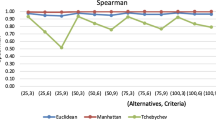Abstract
The paper develops a new intuitionistic fuzzy (IF) programming method to solve group decision making (GDM) problems with interval-valued fuzzy preference relations (IVFPRs). An IF programming problem is formulated to derive the priority weights of alternatives in the context of additive consistent IVFPR. In this problem, the additive consistent conditions are viewed as the IF constraints. Considering decision makers’ (DMs’) risk attitudes, three approaches, including the optimistic, pessimistic and neutral approaches, are proposed to solve the constructed IF programming problem. Subsequently, a new consensus index is defined to measure the similarity between DMs according to their individual IVFPRs. Thereby, DMs’ weights are objectively determined using the consensus index. Combining DMs’ weights with the IF program, a corresponding IF programming method is proposed for GDM with IVFPRs. An example of E-Commerce platform selection is analyzed to illustrate the feasibility and effectiveness of the proposed method. Finally, the IF programming method is further extended to the multiplicative consistent IVFPR.









Similar content being viewed by others
References
Atanassov, K. T. (1986). Intuitionistic fuzzy sets. Fuzzy Sets and Systems, 20, 87–96.
Bellman, R. E., & Zadeh, L. A. (1970). Decision making in fuzzy environment. Management Science, 17(4), 141–164.
Chen, L., & Xu, Z. (2015). A new fuzzy programming method to derive the priority vector from an interval reciprocal comparison matrix. Information Sciences, 316(20), 148–162.
Chen, H., & Zhou, L. (2011). An approach to group decision making with interval fuzzy preference relations based on induced generalized continuous ordered weighted averaging operator. Expert Systems with Applications, 38(10), 13432–13440.
Genç, S., Boran, F. E., Akay, D., & Xu, Z. (2010). Interval multiplicative transitivity for consistency, missing values and priority weights of interval fuzzy preference relations. Information Sciences, 180(24), 4877–4891.
Hauser, D., & Tadikamalla, P. (1996). The analytic hierarchy process in an uncertain environment: A simulation approach. European Journal of Operational Research, 91(1), 27–37.
Ishibuchi, H., & Tanaka, H. (1990). Multiobjective programming in optimization of the interval objective function. European Journal of Operational Research, 48(2), 219–225.
Liu, F., & Zhang, W. G. (2014). TOPSIS-based consensus model for group decision-making with incomplete interval fuzzy preference relations. IEEE Transactions on Cybernetics, 44(8), 1283–1294.
Liu, F., Zhang, W. G., & Fu, J. H. (2012). A new method of obtaining the priority weights from an interval fuzzy preference relation. Information Sciences, 185(1), 32–42.
Mikhailov, L. (2002). Fuzzy analytical approach to partnership selection in formation of virtual enterprises. Omega, 30(5), 393–401.
Mikhailov, L. (2003). Deriving priorities from fuzzy pairwise comparison judgements. Fuzzy Sets and Systems, 134(3), 365–385.
Mikhailov, L. (2004). A fuzzy approach to deriving priorities from interval pairwise comparison judgements. European Journal of Operational Research, 159(3), 687–704.
Moore, R. E. (1966). Interval analysis. Englewood Cliffs: Prentice-Hall.
Orlovsky, S. A. (1978). Decision-making with a fuzzy preference relation. Fuzzy Sets and Systems, 1(3), 155–167.
Pang, J., & Liang, J. (2012). Evaluation of the results of multi-attribute group decision-making with linguistic information. Omega, 40(3), 294–301.
Saaty, T. L. (1980). The analytic hierarchy process. New York: McGraw-Hill.
Shen, F., Xu, J. P., & Xu, Z. S. (2015). An automatic ranking approach for multi-criteria group decision making under intuitionistic fuzzy environment. Fuzzy Optimization and Decision Making, 14(3), 311–334.
Wang, Y. M., & Elhag, T. M. S. (2007). A goal programming method for obtaining interval weights from an interval comparison matrix. European Journal of Operational Research, 177(1), 458–471.
Wang, J., Lan, J., Ren, P., & Luo, Y. (2012). Some programming models to derive priority weights from additive interval fuzzy preference relation. Knowledge Based Systems, 27, 69–77.
Wang, Z. J., & Li, K. W. (2012). Goal programming approaches to deriving interval weights based on interval fuzzy preference relations. Information Sciences, 193, 180–198.
Wang, Y. M., Yang, J. B., & Xu, D. L. (2005). A two-stage logarithmic goal programming method for generating weights from interval comparison matrices. Fuzzy Sets and Systems, 152(3), 475–498.
Xu, Z. S., & Chen, J. (2008). Some models for deriving the priority weights from interval fuzzy preference relations. European Journal of Operational Research, 184(1), 266–280.
Xu, Z. S., & Da, Q. L. (2003). An approach to improving consistency of fuzzy preference matrix. Fuzzy Optimization and Decision Making, 2(1), 3–12.
Xu, Y., Wang, H., Sun, H., & Yu, D. (2014). A distance-based aggregation approach for group decision making with interval preference orderings. Computers and Industrial Engineering, 72, 178–186.
Zhu, B., & Xu, Z. S. (2014). A fuzzy linear programming method for group decision making with additive reciprocal fuzzy preference relations. Fuzzy Sets and Systems, 246, 19–33.
Acknowledgments
This research was supported by The National Natural Science Foundation of China (Nos. 71061006, 61263018 and 11461030), The Natural Science Foundation of Jiangxi Province of China (No. 20161BAB201028), Young scientists Training object of Jiangxi province (No. 20151442040081), The Science and Technology Project of Jiangxi province educational department of China (Nos. GJJ150463 and GJJ150466), Graduate Innovation Foundation of Jiangxi province (No. YC2015-B055), Guangxi Philosophy and Social Science Programming Project (No.15FGL011) and the Excellent Young Academic Talent Support Program of Jiangxi University of Finance and Economics.
Author information
Authors and Affiliations
Corresponding author
Rights and permissions
About this article
Cite this article
Wan, SP., Wang, F., Xu, Gl. et al. An intuitionistic fuzzy programming method for group decision making with interval-valued fuzzy preference relations. Fuzzy Optim Decis Making 16, 269–295 (2017). https://doi.org/10.1007/s10700-016-9250-z
Published:
Issue Date:
DOI: https://doi.org/10.1007/s10700-016-9250-z




